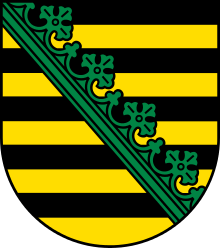Martin Mutschmann
| Martin Mutschmann | |
|---|---|
 Mutschmann (center) with Hitler (right) | |
| Gauleiter of Saxony | |
|
In office 1925–1945 | |
| Preceded by | None |
| Succeeded by | None |
| Reichsstatthalter of Saxony | |
|
In office 1933–1945 | |
| Prime Minister | Manfred Freiherr von Killinger, Himself |
| Preceded by | None |
| Succeeded by | None |
| Minister-President of Saxony | |
|
In office 1935–1945 | |
| Preceded by | Manfred Freiherr von Killinger |
| Succeeded by | Rudolf Friedrichs |
| Personal details | |
| Born |
March 9, 1879 Hirschberg, Principality of Reuss-Gera, German Empire |
| Died |
February 14, 1947 (aged 67) Moscow, USSR |
| Political party | National Socialist German Workers' Party (NSDAP) |
Martin Mutschmann (9 March 1879 – 14 February 1947) was the Nazi Regional Leader (Gauleiter) of the state of Saxony (Gau Saxony) during the time of the Third Reich.
Biography
Born in Hirschberg on the Saale in the Principality of Reuss-Gera, Germany, Mutschmann moved while he was young with his family to Plauen in Saxony. He studied commerce, and eventually opened his own lace factory in Plauen. During World War I, he served on the Western Front until 1916, when he was discharged for medical reasons. After the war, he was an early participant in the nationalist and anti-semitic Deutschvölkischer Schutz und Trutzbund. He was a founding member of the local branch (Ortsgruppe) of the National Socialist German Workers Party (NSDAP) in Plauen and made personal donations of capital to the Nazi Party.
Mutschmann lost his lace business in the Great Depression. But he continued to solicit donations from other businesses. His fundraising skills found favour with the Nazi Party.
Mutschmann was nominated Gauleiter of Saxony in 1925. He maintained this position until the end of World War II. Generally his political activity concentrated on Saxony rather than on Germany as a whole. Mutschmann was passionately interested in the preservation of Saxon arts and crafts.
On 30 January 1933, after the Nazis came to power, Mutschmann was appointed Nazi Governor (Reichsstatthalter) of Saxony. A passionate hunter, he was often accused of being more interested in his hobby than the welfare of Saxony. The bombing of Dresden gave no exception to such accusations. Mutschmann has been blamed for not preparing that city for the horrific bombing, which occurred from 13 February to 15 February 1945.
On 1 May 1945, Mutschmann was in Dresden. As the Gauleiter of Saxony, he insisted that the city go into public mourning after the suicide of German dictator Adolf Hitler on 30 April 1945. On 5 May, Mutschmann let it be known that a large-scale German offensive on the Eastern Front was about to be launched. Two days later, on 7 May, Mutschmann was captured by Soviet troops while trying to escape.[1]
Mutschmann was sentenced to death in Moscow and shot on February 14, 1947.[2]
See also
- German presidential election, 1925
- German presidential election, 1932
- Machtergreifung - "Seizure of Power" - 30 January 1933
- Bombing of Dresden in World War II
- List of Gauleiters
- Ehrenburger Johanngeorgenstadt
